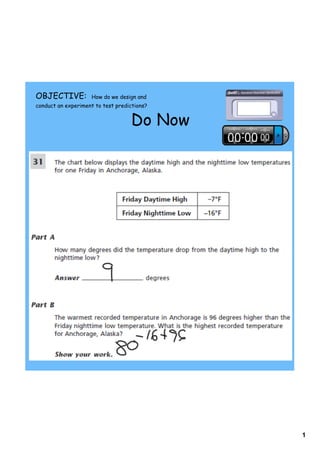Recommended
Recommended
More Related Content
Viewers also liked
Viewers also liked (10)
Similar to Day 2 experiment (20)
More from Erik Tjersland
More from Erik Tjersland (20)
Linear equations lesson 8 day 2 graphing linear equations

Linear equations lesson 8 day 2 graphing linear equations
Linear equations lesson 8 day 1 graphing linear equations

Linear equations lesson 8 day 1 graphing linear equations
Linear equations lesson 5 horizontal and vertical lines

Linear equations lesson 5 horizontal and vertical lines
Module 4.5 lesson 3 computing actual lengths from scale drawings

Module 4.5 lesson 3 computing actual lengths from scale drawings
Linear equations lesson 4 graphing linear equations

Linear equations lesson 4 graphing linear equations
Day 2 experiment
- 1. OBJECTIVE: How do we design and conduct an experiment to test predictions? Do Now 1
- 2. 2
- 3. 3
- 4. Anticipatory Set 1.) If you roll two fair 6-sided die and add the numbers, list all the possible sums. 2.) Which sum do you think will occur most often? Explain your answer. 4
- 5. You just made a prediction. To test that prediction we will conduct an experiment. 3.) Describe the type of experiment you would design to test your prediction. 4.) How many trials of your experiment do you plan on completing? Explain your answer. 5
- 7. 7
- 8. Experimental Probability of Rolling Two Dice Sum of Die Tally Frequency 2 3 4 5 6 7 8 9 10 11 12 8
- 9. Proportion to find the experimental probability of a sum as a percent: 9
- 10. Conclusion 10
- 11. Flipping Two Coins What is the most likely outcome of flipping two coins? a.) Two Heads b.) Two Tails c.) One Head, One Tail 11
- 12. BEFORE YOU LEAVE 1.) Reflect on the number of trial you used. How would the experimental data change if you used more or less trials? 12
- 13. Mr. Tjersland's Math 7 Homework: None 13
